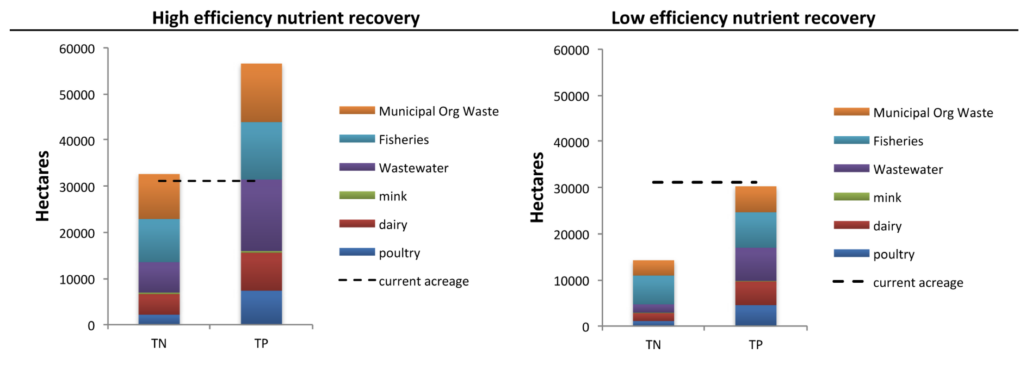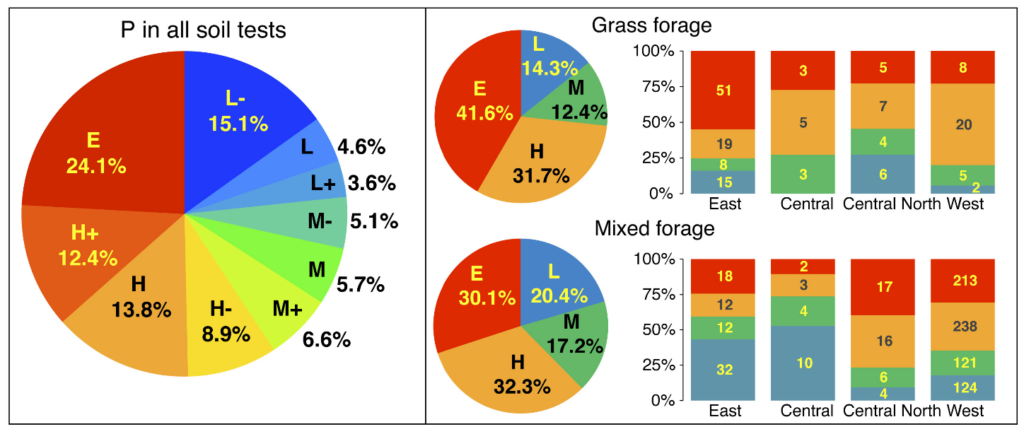Soil fertility and management
For farming to expand northward, and be carried out sustainably and adaptively, one must first well define the physical, chemical and biological context of the soil systems, and integrate the realities of the locally relevant resources to establish the knowledge bases for an informed development of northern cropping. Locally relevant solutions such as use of biochar, rock crushing, and means to re-use of diverse organic waste streams (including fishery wastes); as to the latter, a main focus of the work is to contrast conventional and non-conventional means to maximize utility while reducing management steps and thus costs. Adoption is critically dependent on the adaptability and accessibility of the proposed solution. Local knowledge is central to all assessments; most of the work is carried out on farmers’ fields.
Nitrogen in boreal acid soils
In a natural state a forested Podzol has a relatively tight nitrogen cycle where nitrate and ammonia are taken up by plants at rates matching mineralization with very little leaching. When land is converted from a natural state a series of increases in temperature and oxygen results in an increased mineralization rate by an enhanced microbial activity. Nitrogen in a Podzol can be associated with carbon where the largest pools can be found in dead decaying matter. Smaller pools involve dissolved total N which can be associated with dissolved organic carbon found in illuvial layers. To adequately understand the drivers of the biogeochemical cycles it is important to look at how the mechanisms of mineralization and immobilization are influenced by the soil’s parameters.
Phosphorus in boreal acid soils
In a Podzol the concentration of organic phosphorus can be assumed to be 4% of the total P where the remaining 96% of the total P may be inorganic. Phosphorus is available to plants in forms of phosphate ions, and its uptake occurs directly through roots and hyphae via mycorrhizal associations. Organic phosphorus can be available to plants after mineralization, usually carried out by soil microorganism. Mineralization of organic phosphorus mediates the availability to plants of common soil organic P compounds such as inositol hexaphosphate, lecithin, nucleic acids, nucleotides and glycerophosphate. Overall availability to the plant ultimately relies on the P stores in the soil. If a soil has a low P retention capacity, then the availability of added P would be high. Conversely soils with high P retention capacity limit availability of P. This also affects the availability for P to soil microorganisms that may mineralize organic forms of P. The low availability of organic P to biological transformation may be a result of sorption as well as fixation by soil colloids. Phosphate ions are very reactive and form insoluble complexes with metallic anions including Fe and Al. Nevertheless, under natural conditions P reaches soils mainly in organic forms. The interest in the organic fraction of P in soils is due to the increased mobility compared to inorganic P. The quantification of organic phosphorus is also important to track the balance of P fixation as inorganic P is assimilated into organic P (by microorganisms), while mineralization of organic P from dead OM and from organic compounds excreted by microorganisms and shed at roots’ surfaces . The combination of metallic cations and low pH impact the form of inorganic phosphorus through immobilization making P availability in soils an issue of concern when converting to agricultural land.
Locally relevant fertilizer sources
Commonly, significant amounts of organic materials are added to soils to enhance the fertility of newly converted boreal lands. For example, we assessed the organic waste streams across Newfoundland, Canada identified that wastes contain sufficient nutrients to cover between 50 to 100% of the N and P fertilizer required at the current intensity of agricultural production (figure below, TN=total nitrogen, TP=total phosphorus in local organic waste; image from here).

There is a need to understand how the soil layers that might be variably mixed during LUC, and thus variably contribute to the new plough layer, respond to the addition of locally relevant fertilizers. This will impact agronomic management and the general capacity of the new farmlands to sustain agriculture. Given the current push to expand northern agriculture, it is essential to understand how LUC affects soil biogeochemistry and thus, the chemical speciation and fluxes of plant essential nutrients.
BMP’s; the need for locally calibrated management recommendations
Fertilizer recommendations must be locally calibrated; Podzols have a strong capacity to specifically adsorb phosphorus on iron and aluminium oxides. This may lead to precautionary over-application of phosphorus, but that can rapidly lead to excessive availability as soon as the soils storage capacity for phosphorus is satisfied.

Mehlich-3phosphorus(P)across >1500 farm soil tests and the total and regionally distributed P for two crops common across all Newfoundland regions. (Figure from Kedir et al., 2021)
Projects

BioSoil North
In search of food security in the boreal regions of Canada land use conversion (LUC) is used to expand agriculture into boreal forests or natural lands. LUC is strongly supported…
Carbon in Global Boreal and Alpine Soils Under Climate Change-Driven Land Use
Hugh C. Morris Experiential Fellowship (Kimberley Foundation) The Hugh C. Morris Experiential Fellowship sends a student away from the complacency of their home institution (classroom and laboratory) to study at…
Influence of Crushed Rock on Soil Suitability for Crop Production
A fast online search for information leads to numerous non-scientific articles that tout rock and rock dust as effective soil amendments for improving soil quality, enhancing its carbon storage capacity,…
Composting, vermicomposting
coming soon
Environmental and Soil Health, Phosphorus Dynamics in the Soil
Phosphorus Dynamics in Boreal Podzols Converted from Forest to Agriculture Phosphorus (P) stands as a non-renewable, essential element crucial for sustaining all life forms, particularly in agriculture, where it ranks…
Biochar and Fish Waste for Soil Fertility
Farms in the northern cold-climate regions of Canada are: (1) small (<100ac) and thus not amenable to large scale farming protocols; (2) are established either on less fertile soils that…
Articles

The rate dependent efficacy of biochar for crop yield and nutrition on Podzols newly converted from boreal forests
Abedin J, Unc A, 2023. Field Crops Research, 303: 109121 Context Under climate change and local and global food security pressures conversion to agricultural lands on Podzols developed under boreal forests is accelerating across the global north. After conversion Podzols, acid and sandy, are infertile requiring significant management…
Microbial denitrification
M. J. Goss, S. Blagodatsky and A. Unc, In: Encyclopedia of Soils in the Environment (Second Edition), edited by M. J. Goss and M. Oliver, Volume 1, 2023, Pages 261-269, Academic Press https://doi.org/10.1016/B978-0-12-822974-3.00282-2 Denitrification is the transformation of plant available nitrogen…
Septic systems and municipal waste disposal on land
C. P. Gerba, M. J. Goss and A. Unc, In: Encyclopedia of Soils in the Environment (Second Edition), edited by M. J. Goss and M. Oliver, Volume 1, 2023, Pages 567-577, Academic Press https://doi.org/10.1016/B978-0-12-822974-3.00286-X On-site – mainly septic systems – and…
Impact of fertilizer source on the dynamics of carbon and nutrients in a podzol designated for land-use conversion.
Tingskou, R., & Unc, A. (2023). Soil Use and Management, 39, 1491–1503. https://doi.org/10.1111/sum.12906 Boreal lands have long been considered unsuitable for agriculture. Climate change projections support a shift towards increased agricultural production in boreal ecosystems via land use conversion. Depending on the conversion protocol, the new…
Comparison of agri-environmental phosphorus tests for boreal agricultural and natural Podzols
A. J. Kedir, D. B. McKenzie, N. Ziadi and A. Unc, Canadian Journal of Soil Science 2022 Vol. 103 Issue 1 Pages 234-248, https://doi.org/10.1139/cjss-2022-0037 Over a dozen soil phosphorus (P) extraction procedures have been designed for agri-environmental purposes (P-tests). Sustainable…
Utility of wood ash, paper sludge and biochar for the mitigation of greenhouse gases emissions from acid boreal soils
A. O. Medaiyese, J. Wu and A. Unc, Journal of Environmental Management 2023 Vol. 330 Pages 117202 https://doi.org/10.1016/j.jenvman.2022.117202 Land-use change in the boreal forest region leads to agriculture to be carried out on acid, shallow and low fertility soils. To…
The impacts of rock pulverization on soil quality and functional soil nematode and respiration properties of boreal lands converted from forest to agricultural use
E. H. Young, J. D. Vallotton, A. J. Kedir, A. O. Medaiyese, C. Goyer, L.-P. Comeau and A. Unc, Canadian Journal of Soil Science 2022 Vol. 102 Issue 4 Pages 977-990, https://doi.org/10.1139/cjss-2022-0007 Rock pulverization is recommended when converting boreal forests…
Phosphorus Sorption Capacity and Its Relationships With Soil Properties Under Podzolic Soils of Atlantic Canada
Kedir AJ, Nyiraneza J, Hawboldt KA, McKenzie DB and Unc A (2022) Front. Soil Sci. 2:931266. https://doi.org/10.3389/fsoil.2022.931266 Repetitive long-term fertilizer application leads to phosphorus (P) accumulation in agricultural soils. This can pose environmental risks if the soil’s phosphorus storage capacity is…
The utility of biochar for increasing the fertility of new agricultural lands converted from boreal forests
J. Abedin and A. Unc, Canadian Journal of Soil Science 2021 Vol. 102 Issue 1 Pages 165-176, https://doi.org/10.1139/cjss-2021-0002 The agricultural soils of the Happy Valley-Goose Bay (HV-GB) region of Newfoundland and Labrador, Canada are Podzols that are converted from boreal…
Understanding soil fertility status in Newfoundland from standard farm soil tests
Kedir AJ, Mingchu Z, Unc A. 2021. Canadian Journal of Soil Science. 101(3): 517-531 https://doi.org/10.1139/cjss-2020-0108 Farm soil tests are common decision support tools employed by regulatory agencies and farmers to manage nutrients in an economical and environmentally sustainable way. The complex interplay between…
Phosphorus adsorption characteristics in forested and managed podzolic soils
A. J. Kedir, J. Nyiraneza, L. Galagedara, M. Cheema, K. A. Hawboldt, D. B. McKenzie and A. Unc, Soil Science Society of America Journal 2021 Vol. 85 Issue 2 Pages 249-262, https://doi.org/10.1002/saj2.20180 Despite the agricultural expansion into Canada’s boreal ecoregion,…
Addition of biochar to acidic boreal podzolic soils enhances micronutrient availability and crop productivity
J. Abedin and A. Unc, Open Agriculture, vol. 5, no. 1, 2020, pp. 188-201, https://doi.org/10.1515/opag-2020-0021 Results of a recent multiyear experiment conducted on an agricultural plot that was recently converted from boreal forest (Labrador, Canada) suggested that NPK fertilizers contributed…
Enhancing Soils of Labrador through Application of Biochar, Fishmeal, and Chemical Fertilizer
J. Abedin, Agronomy Journal 2018 Vol. 110 Issue 6 Pages 2576-2586, https://doi.org/10.2134/agronj2018.02.0074 Core Ideas: Biochar applied to sandy, acidic soil increased topsoil pH by 0.5 units. Biochar, fertilizer, or fishmeal alone was unable to support crop establishment, growth, and biomass…
Organic Waste in Newfoundland and Labrador: A Review of Available Agriculture, Fishery, Forestry and Municipal Waste Literature.
Butler, Lesley, Altdorff, Daniel, Young, Erika, Galagedara, Lakshman, Hawboldt, Kelly, Helleur, Robert J., Unc, Adrian (2017) Research Report. Memorial University of Newfoundland, St. John’s, Newfoundland and Labrador; https://www.mun.ca/harriscentre/media/production/memorial/administrative/the-harris-centre/media-library/reports/UNC_WASTE_15-16.pdf Re-utilisation of organic waste is globally widely employed to maximize both economic and environmental sustainability of human activities. Re-‐‑utilisation of…

